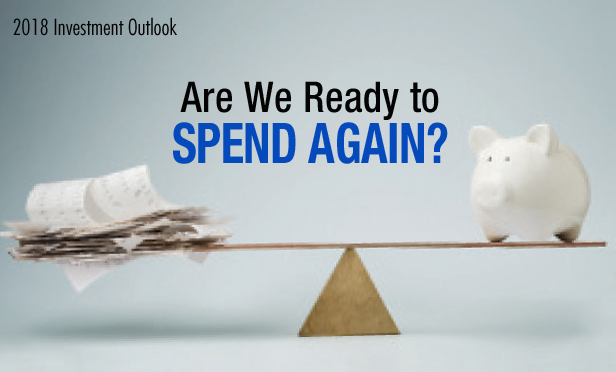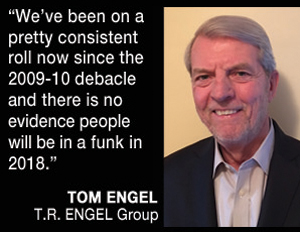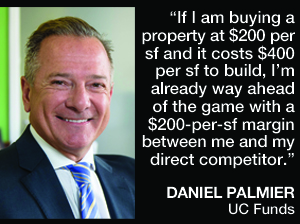Washington, DC-based Zavazone is a startup retailer that has just opened its second location in a nearby suburb but that nascent track record hasn't stopped malls from around the country from contacting the company about setting up in their retail center.
“We have been contacted by malls in the Midwest, by multiple malls in New York and New Jersey and as far south as Texas,” says co-founder Joe Henry.
The outreach is a testament to Zavazone's interesting concept—it is an indoor adventure park open to anyone that wants to walk across its catwalks or bounce on its trampolines—but it is also illustrative of how eager malls are to attract retailers that provide an experience to shoppers.
Yes, there is activity in retail—even by malls. For all the woes that the sector has experienced this year, when all is said and done US retailers will have opened some 4,100 more stores than they will have closed in 2017, according to a recent report by TH Real Estate. Many will be along the lines of what Zavazone represents: a unique experience that cannot be replicated online.
But Zavazone tells an even larger story for the commercial real estate industry: it's not just the beleaguered retail asset class that is ready for a rebirth next year —almost all of the CRE asset classes had a dismal 2017 when judged against one very important metric: investment sales.
It is still open for debate how much of an improvement 2018 will be. Or if there will be much of an improvement at all, for that matter. For the optimistic among us, though, there is reason to hope.
A BUMPY START
Indisputably, the year started out as a disappointment. There was the shadow of a new presidential administration and concern that the maturing cycle might end on a not-so-gentle note. First-quarter investment sales reflected these worries: transactions dropped by 18% year over year, according to National Association of Realtors figures. The quarter also saw the beginnings of a pricing disconnect between buyers and sellers, which still continues. New worries also arose as the year wore on, such as policy decisions over healthcare and now, tax reform.
These trends combined to create a lackluster first half. Statistics from the Mortgage Bankers Association show that apartment sales as of the end of the second quarter were down 17% Y-O-Y, while office and retail saw respective declines of 2% and 16%. Only the industrial asset class posted growth, of 10%.
These numbers change, of course, depending on the location. Washington, DC—Zavazone's home town—is having a good year, relatively speaking. There, local office investment sales are on track to equal or even slightly exceed those in 2015, according to stats from Newmark Knight Frank's Greg Leisch, senior managing director of market research with the firm. Compare that with New York City's investment sales for office, which are down about 40% Y-O-Y, according to NKF's Sandy Paul.
Of course, Q4 sales need to be tallied up and if past history is any guide, brokers will be working until the midnight hour on New Year's Eve to close out the books. Unfortunately, some of the trends that weighed down on sales in the first half are still present and will likely continue through the beginning of 2018.
There are still worries about macroeconomic events, although Leisch, for his part at least, dismisses these as so much white noise. “There will always be reason for hesitation,” he says. “Each year we find a new reason—the Dow seems too high, or we have a new administration, or there's concern over the deal with Iran, or saber rattling with North Korea.” There will always be reasons for hesitation in the market, he reasserts, and there will always be that one-quarter turn in sales that were lower than expected and disappoint.
Another nettlesome trend still present in the market: buyers and sellers are still at loggerheads about pricing, says Green Street Advisors analyst Joi Mar. “Investors are weighing record prices, slowing property fundamentals, Fed tightening and uncertainty around policy reform—especially taxes,” she says. There are also structural changes under way in some asset classes such as retail. “Most, if not all, of these issues are likely to bleed into 2018.”
What is likely, she predicts, is that sellers will move toward the bid price. That's what usually happens—instead of the other way around—since buyers aren't pressured to transact, while sellers may need to exit.
So far, though, that has shown little sign of occurring.
In October the Green Street Commercial Property Price Index declined by 1%. Y-O-Y, the index was also down by 1%, while over the trailing three months, it was flat. Still, the firm cautioned against making broad assumptions from this drop. The index, it turned out, was pushed down in October by falling mall valuations. Prices for most other property types were stable.
“In aggregate, prices have plateaued, but it's really a mixed bag when it comes to property pricing,” says Peter Rothemund, senior analyst with Green Street. “Industrial, medical office, life science—they've all done great over the past year. Malls have been weak. And everything else has been somewhere in between.”
SIGNS OF HOPE
All that said, there are signs that this pause in investment sales—and the trends driving it—may end in 2018 or, at the very least, improve. For starters, by the beginning of the year it will be clear whether Congress will be able to pass some version of tax reform. The market will then know and be able to proceed with plans and, hopefully, purchases.
Also, fundamentals in the second half of the year have turned out to be surprisingly strong, leaving many in the industry to conclude that the cycle is positioned to continue longer than was thought at the beginning of the year.
Real Capital Analytics made this observation in its third-quarter US Capital Trends Report. Deal volume as of Q3 was the most challenged “in sectors where unique stories on market dynamics are forcing investors to reassess their assumptions. By contrast, the last downturn impacted all property types and deal structures by impeding financial channels.”
Most intriguingly, RCA wrote that, “the fact that there are pockets of growth suggests that the slowdown in sales is not a sign of an impending broader calamity. Rather, there are unique features for each property type and deal structure influencing market trends.”
DIGGING INTO RETAIL'S FAILURES
Consider the example of retail. One theory for the lack of sales—and RCA did cite this as one of the reasons—is that owners of the best assets are reluctant to test the market amid the torrent of bad news about the sector. Only the assets that had to sell went to the market where they were promptly pummeled. Hence the conclusion that the retail sector is weak.
To be sure, it has structural issues, many of which still must be resolved. But more insight can be had by digging into the reasons for the many failures this year, says Sam Latone, co-CEO of the Shopping Center Group.
The types of retail that foundered fell into two different categories, he explains. One was the retail chains owned by private equity firms. Typically what they did was leverage the retail chains up with massive amounts of debt and when the downturn came, they couldn't reinvest in the stores or the people. “It was a financial construct as opposed to an operating retail chain driven by merchandising and customer service,” Latone says.
Another category of failed retailers, he continues, were those chains that for whatever reason over the years failed to reinvest and reinvent themselves in a way that resonated with the consumer. “They have been doing business the same way for many years and as retail evolved and consumer tastes and preferences changed they simply failed to keep up.”
E-commerce, of course, has been pressuring brick-and-mortar stores and the retailers that have been able to survive, Latone says, are the ones that have blended their online and offline operations, presenting a seamless front to the consumer. Consider Wal-Mart: it's become a cause célèbre of sorts as it did not succumb to the Internet or Amazon but instead was able, after a fumbling start, to marry e-commerce with its brick-and-mortar presence.
Recently Wal-Mart announced that it expects its US e-commerce business to increase its online sales by 40% for fiscal year 2019. That's a formidable projection, considering its online operations are now five years old, although perhaps not as much in light of the fact that its online sales skyrocketed by 60% in this year's Q2.
“I applaud Wal-Mart for recognizing that they need to take a unified approach to their customer,” Latone says.
Another category in this space that is doing well are the experience retailers, such as Zavazone. Experiences—as opposed to acquiring things—are also part of the changing consumer landscape to which Latone refers.
Recognizing this, more experience retailers are coming to market, Transwestern vice president Nathan Bortnick says. “The retailer landscape is changing and there are new concepts, and landlords are looking for the next great exciting thing.”
“DO I HARVEST MY EQUITY?”
The interesting developments in retail notwithstanding, transactions in this category are widely expected to remain slow. The bottom line is that the headline news, while misleading in many respects, will still rule the day for the time being. As RCA stated in its Q3 report, the torrent of bad news about retailers is limiting investor appetite.
Hotels are another category that are expected to see slow transaction growth in 2018, albeit for quite different reasons.
To be sure the industry will continue to have healthy revenues and profits next year, says Tom Engel, principal of T.R. ENGEL Group of Boston. “We've been on a pretty consistent roll now since the debacle in 2009-2010 and there's no evidence we can see that people will be in a funk in 2018.”
As for fundamentals, he predicts a slowdown in average daily rate—mainly because of new supply coming on line in New York, Chicago, San Francisco and Houston—but not much of a slowdown in occupancy. In short, operating results for 2018 should continue to be positive—and that is the reason for the expected slow pace of hotel transactions. “When profits have experienced the kind of growth they have over the past four to to six years, and you look to buy assets in that environment,” he says, “obviously sellers want more and capitalization rates decline.”
For instance, Engel says that if five years ago, you were looking at a hotel with a dollar of profit and an 8% to 9% cap rate, that looked great. Five years later, that dollar is maybe now $2.50 and cap rates have dropped to 5% “All of a sudden as a buyer you're saying, 'Why didn't I do this five years ago?' And as a seller, you're now confronted with the issue of 'Do I harvest the equity that I've created over the past five years, or do I continue to ride a favorable storm?'”
This is Engel's best guess about how transactions will flow next year for hotels: overall there will be fewer transactions, with few sales taking place in the first quarter. But through the second through fourth quarters, owners that realized real growth in the bottom line will subsequently be looking to exit. And the buyers of those assets probably won't be US private equity, but rather, foreign capital sources that can live with the lower cap rates.
While retail and hotels are going to nuanced, slow-burning stories next year, they are not the only narrative for commercial real estate. Industrial is firing on all cylinders, while another perennial favorite—value add multifamily—can be expected to attract reasonable amounts of investment as well.
“Right now, people are trying to get their portfolios weighted more on those two asset classes,” says Mitch Paskover, president of Continental Partners in Los Angeles. “That will continue in 2018.”
A NEVER-ENDING GROWTH STORY
Industrial is likely to show the most price appreciation in 2018, says Green Street's Mar. “Demand for industrial continues to impress while new supply appears reasonable,” she says. “We expect industrial market rent growth to continue to be healthy, led by infill locations in urban areas.”
RCA and the Society of Industrial and Office Realtors recently published a survey of SIOR's members and found 51.8% of brokers felt activity would increase over the next 12 to 18 months. Another 39% felt activity would remain at its present high level. Further, pricing is expected to increase over the same period. Many survey respondents predicted a growth rate of at least a 5%, and possibly twice that level.
There's no dearth of buyers, with institutional investors, REITs, private investors and many foreign investors all eager to take participate. Jack Fraker, of CBRE in Dallas, noted in the report “that many large deals are attracting more than 100 potential buyers.”
Demand is so great that JLL is predicting secondary markets will continue to see heightened levels of activity in the coming year. For the first half of 2017, the industrial asset class closed $24 billion in sales with primary market activity accounting for 40.8% of sales—but it was the secondary markets at 43% that led the way. Meanwhile, tertiary markets, with 16.2% growth, showed significant momentum. Investors want to strike that balance between finding the right geography and getting the return they need—and smaller markets allow them to underwrite that, JLL said in a recent report.
There is little secret what's behind this demand; much of it is being fueled by the growth of e-commerce. One nuanced change that the industry may see in the coming year is a shift in last-mile strategies by Amazon, now that it has acquired Whole Foods. The theory is that Amazon will make use of Whole Foods' distribution channels for its own last mile delivery points.
A PERENNIAL FAVORITE
Multifamily is another asset class that should see a good bit of action next year, with an emphasis on value-add properties. Simply put, the numbers pencil in nicely for most locales.
Daniel Palmier, president and CEO of UC Funds, tells of one property the firm acquired at a bankruptcy auction last year—an apartment property that was well-located but under managed and, as he put it, a little tired looking. “We were able to buy the property much cheaper than we could ever build it,” he says.
Here is his reasoning: “If I'm buying a property at $200 per sf, and it costs $400 per sf to build, I'm already way ahead of the game with a $200-per-sf margin between me and my direct competitor.
“So then I put some investment in to compete more effectively—let's say that is $50 per sf,” he goes on. “So now my investment is $250 per sf against my competitor, which built his product at $400 per square foot. Now we're both getting the same effective rent because even if the competitor is advertising a higher rent, it has to give away higher concessions such as two months' free rent.
“At the end of the day,” he concludes, “I am putting as much money per unit in my pocket as they are at a return on investment that is significantly better than theirs.” UC Funds has been investing in multifamily for years relying on such numbers to make their returns, Palmier says. But the environment right now is particularly well suited for value add.
Indeed, analysts are expecting deceleration in rent growth and, with that, in revenue growth as well for the upcoming year as peak supply goes live. “While we expect renter demand to continue to remain robust, we are predicting vacancies to rise given the amount of new projects that are coming on line,” Reis chief economist Victor Calanog wrote in a recent study.
Those properties were planned and developed when the cycle was more robust. The market has obviously changed since then, but by precisely how much remains to be seen.
© Touchpoint Markets, All Rights Reserved. Request academic re-use from www.copyright.com. All other uses, submit a request to [email protected]. For more inforrmation visit Asset & Logo Licensing.













